Contrary to popular belief, ducks don’t just come in yellow or white colors alone. These birds do exist in other colors such as brown, black, gray, green, and a combination of all those colors. However, there are also certain duck breeds that possess black and white plumage.
Depending on the species, some black and white ducks can be raised domestically. Others live freely in the wild and aren’t suitable for homesteading or backyard-raising. In this article, we have listed some of the beautiful and unique black and white duck breeds.
Let’s take a closer look at each of them.
Table of Contents
Hooded Merganser (Lophodytes cucullatus)

Hooded mergansers can be found in Canada and the United States, particularly in Southern Canada, Mississippi, Delaware, Texas, and around the Pacific Northwest. They live in different habitats such as lakes, ponds, marshes, swamps, freshwater regions, estuaries, and along the coasts.
These small diving ducks measure around 16 to 20 inches long and weigh around 19 to 24 ounces.
They have distinctive, fan-like crests with white side patterns on their black head, long and narrow black bills, brownish-black backs, yellow eyes, and white underparts. Meanwhile, female ducks are much simpler with dull brown plumage.
Hooded mergansers usually nest in abandoned nests or tree cavities near water. Female ducks can lay around 10 to 12 white eggs that take around 33 days to incubate. These wild ducks feed mainly on marine creatures such as small fish, crustaceans, mollusks, aquatic insects, and occasionally, some plants.
Tufted Duck (Aythya fuligula)
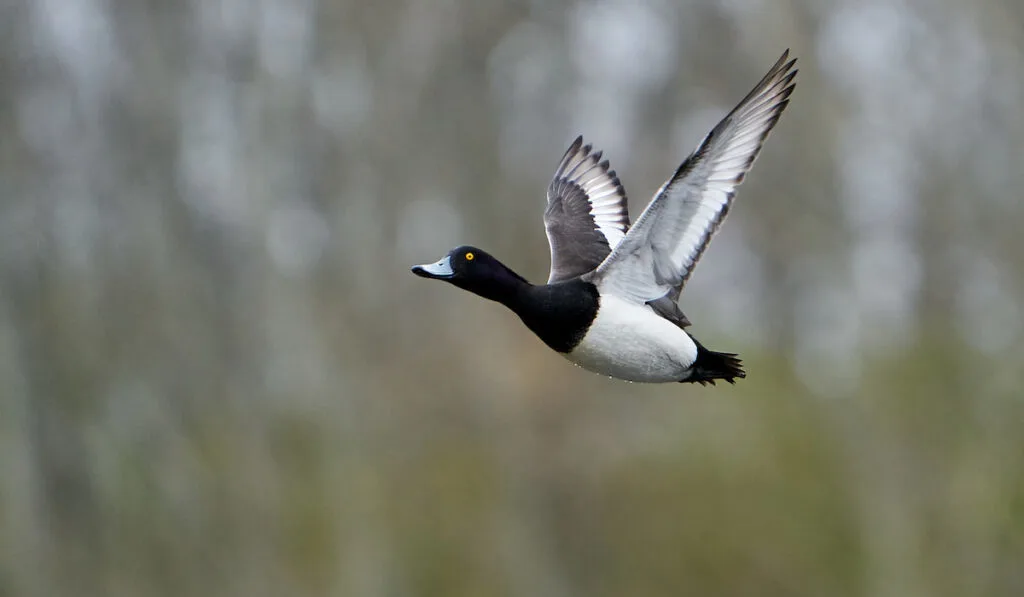
Tufted ducks are distributed in many regions including Canada, Alaska, Western Europe, Southern Asia, Iceland, as well as the United States.
They are also known as the tufted pochard. These small diving ducks inhabit varieties of habitats such as lakes, marshes, ponds, shorelines, and coastal regions.
Tufted ducks can be recognized by their black crested head, black chest and back, yellow eyes, whitish-gray bills, and white wings. Female ducks are slightly different with mottled brown bodies, pale planks, yellow eyes, and white underparts.
These ducks measure 16 to 18 inches long and weigh around 1.7 to 2 pounds. Their wings can also extend up to 28 inches wide.
These diving ducks feed primarily on mollusks, aquatic insects, seeds, and occasionally, some plants. Tufted ducks usually nest in hidden spots that are close to water. Female ducks can lay 8 to 12 cream-colored eggs before incubating them for 24 to 27 days.
They have a lifespan of around 4 years. But in some cases, healthy ducks can live up to 15 years.
Common Eider (Somateria mollisima)
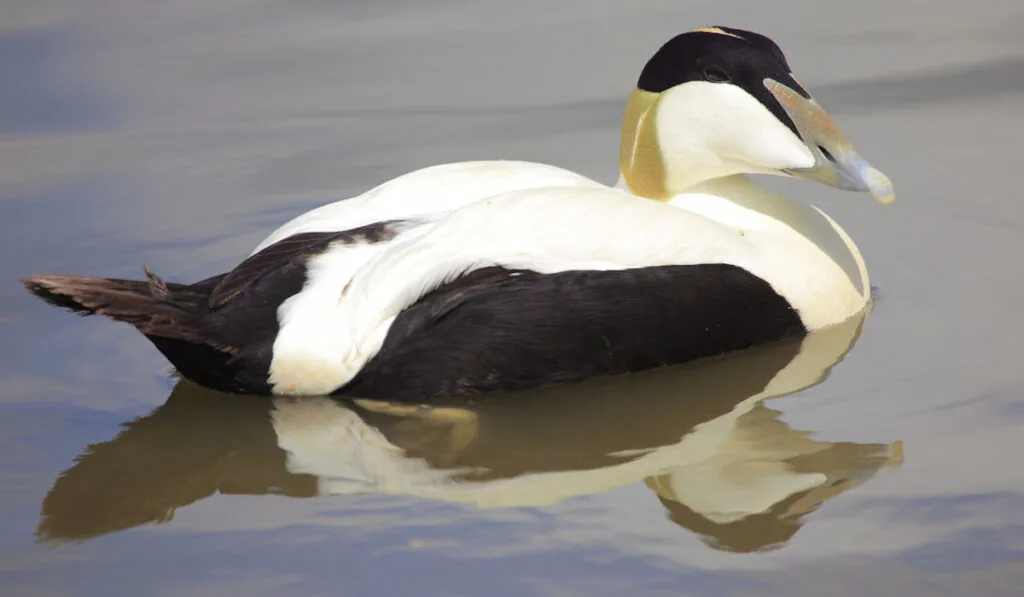
Common eiders are commonly found in North America, Eastern Siberia, and Northern Europe. During their breeding seasons, these ducks migrate to different regions all around the world such as Alaska, the Arctic, northeast Asia, Greenland, northeast Canada, and Iceland. They are also known as Cuddy ducks or St. Cuthbert’s ducks.
Common eiders generally measure around 20 to 28 inches long and weigh around 1 to 6 pounds. These large waterfowls possess large bodies, black crowns and underparts, white breasts, backs, upper wings, and pale-yellow wedge-shaped bills. Female eiders are mottled-brown and don’t appear as striking as the males.
These ducks’ primary sources of food includes mollusks, small fish, aquatic insects, and some plant materials. They usually nest on the ground close to water.
Female eiders can lay 3 to 8 olive-gray eggs that take 23 to 30 days to be incubated. Being colonial breeders, they also tend to nest in the same regions that they have been in before.
Ring-necked Duck (Aythya collaris)
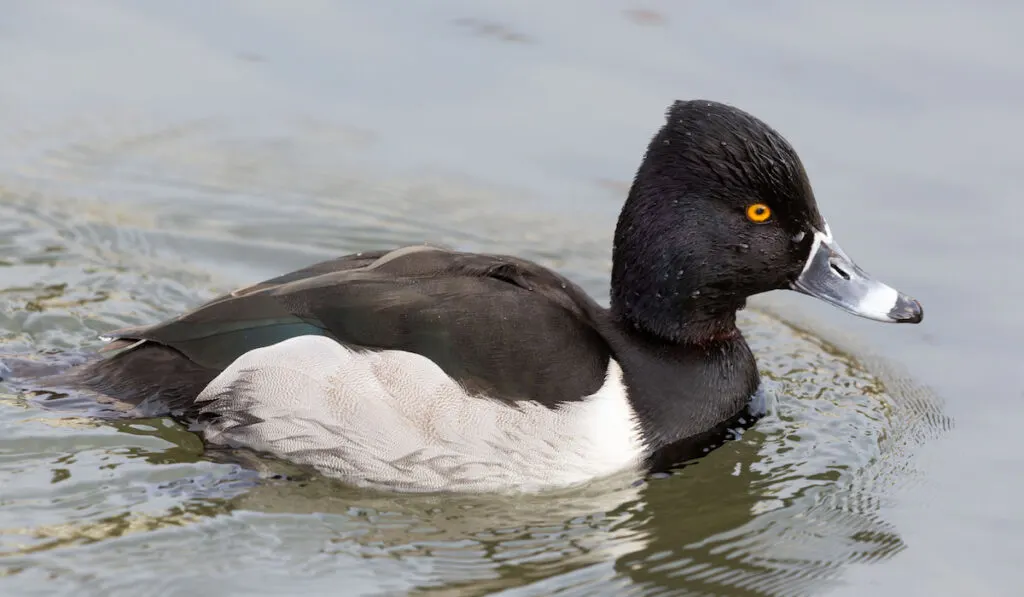
Ring-necked ducks are distributed throughout North America, Canada, Alaska, and Northern United States. They are migratory ducks that inhabit diverse types of habitats including ponds, lakes, rivers, marshes, estuaries, as well as coastal bays.
Ring-necked ducks can be recognized by their black bodies and heads, white wings and underparts, and yellow eyes. They also have white patterns on their black bills and subtle deep brown rings around their neck. These diving ducks measure 15 to 18 inches long and weigh 17 to 32 ounces. Their wings can extend up to 25 inches wide.
Ring-necked ducks usually feed on different aquatic plants, seeds, insects, and mollusks. Female ducks often lay 6 to 14 pale buff eggs before incubating them for 25 to 29 days. Once they are hatched, the mothers will lead their ducklings to the water to feed.
White-winged Scoter (Melanitta deglandi)
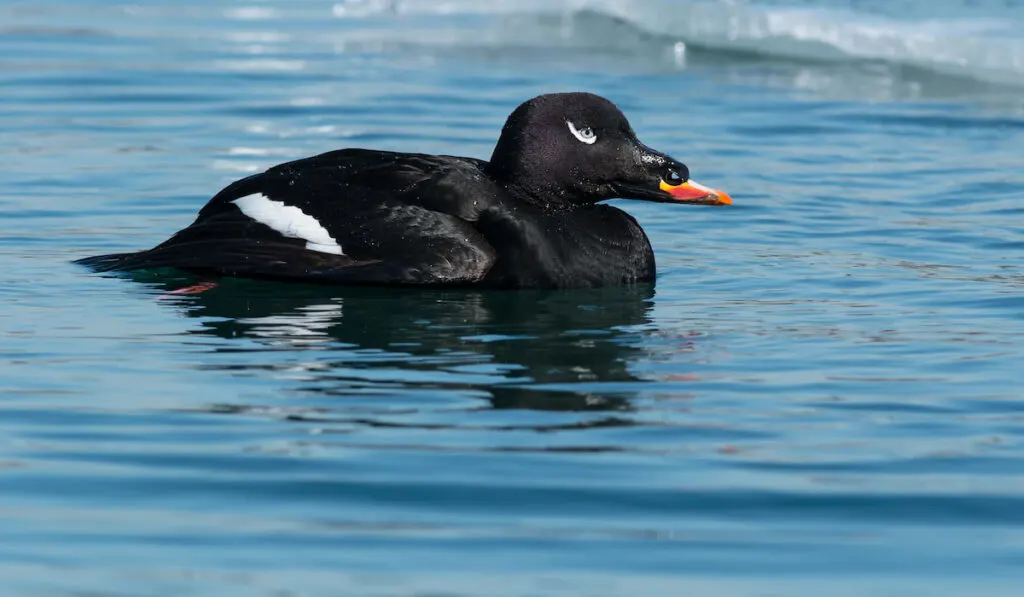
White-winged scoters are native to North America. They are often found around Alaska, Western and Southern Canada, as well as the northern part of the United States.
Although they are mostly found near the ocean, these ducks also inhabit rivers, lakes, and ponds. Being one of the largest Scoter species, they measure 19 to 24 inches long and weigh 3 to 5 pounds.
White-winged scoters are distinguished by their black plumage, yellowish-orange bills, white speculums, and white rings around their eyes.
Female scoters are completely different with their characteristic all-brown plumage. These large diving ducks love to feed on mollusks, small fish, aquatic insect crustaceans, and occasionally, some plant materials.
Female scoters can lay 9 to 12 pink-colored eggs that take 25 to 30 days to be incubated. Their nests are often built close to water on the ground.
Ancona Duck (Anas Platyrhynchos domesticus)
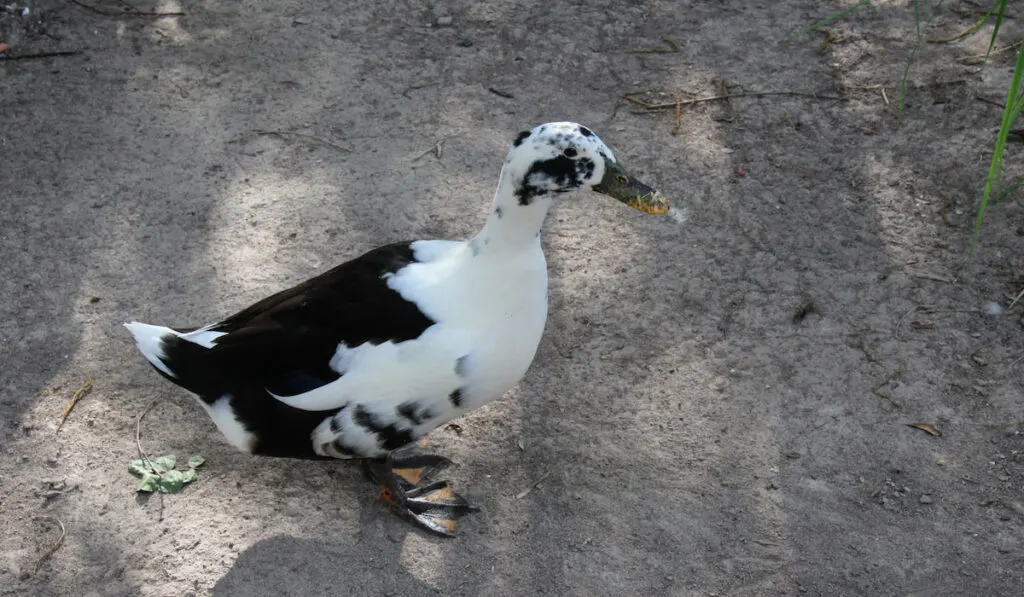
Ancona ducks are domesticated ducks that are commonly raised by many duck breeders and farm owners. They are dual-purpose ducks that could produce both flavorful meat and eggs. These large-sized ducks are native to England and were developed from a crossbreed between Runner and Huttegen ducks.
Ancona ducks are classified as endangered species by the American Livestock Breeds Conservancy in 2015. On average, adult ducks weigh 6 to 7 pounds.
They have bi-colored plumage that consists of a mix of two colors such as black and white, blue and white, grayish-silver and white, and chocolate and white.
These ducks also have dark green and yellow concave-shaped bills and orange legs. Unlike most wild ducks, Ancona ducks can’t fly. However, they are hardy species, good foragers, calm, and make great farm ducks.
King Eider (Somateria spectabilis)
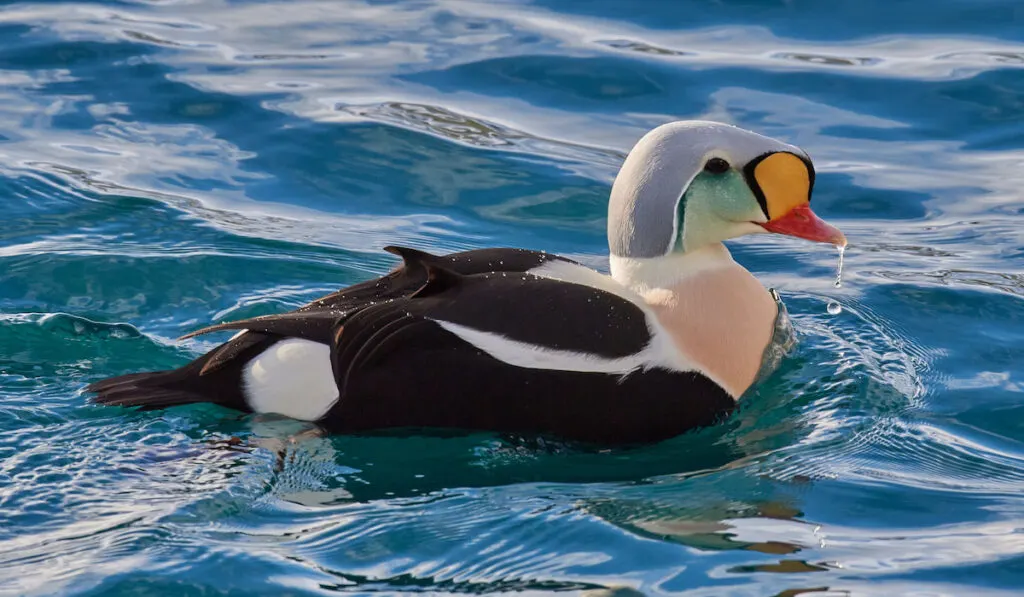
King eiders are distributed in North America, Northeast Europe, and Asia. During their migrating seasons, they can be found in Northeast Canada, Alaska, and a few regions in the United States such as Kansas, Florida, Southern California, and Louisiana.
These ducks usually inhabit different habitats such as freshwater lakes, coastal waters, arctic tundras, and subarctic regions.
King eiders measure 20 to 28 inches long and weigh 2 to 4 pounds. Their wings can extend up to 40 inches wide.
These large sea ducks can be recognized by their colorful heads, black bodies, white breasts, and orange bills. Meanwhile, the color of female ducks is much duller with brown plumage and black bills.
King eiders feed on mollusks, aquatic insects and larvae, crustaceans, and some plant materials. They usually nest on the ground and close to water. Female eiders can lay 3 to 7 pale olive eggs before incubating them between 22 to 24 days.
Barrow’s Goldeneye (Bucephala islandica)
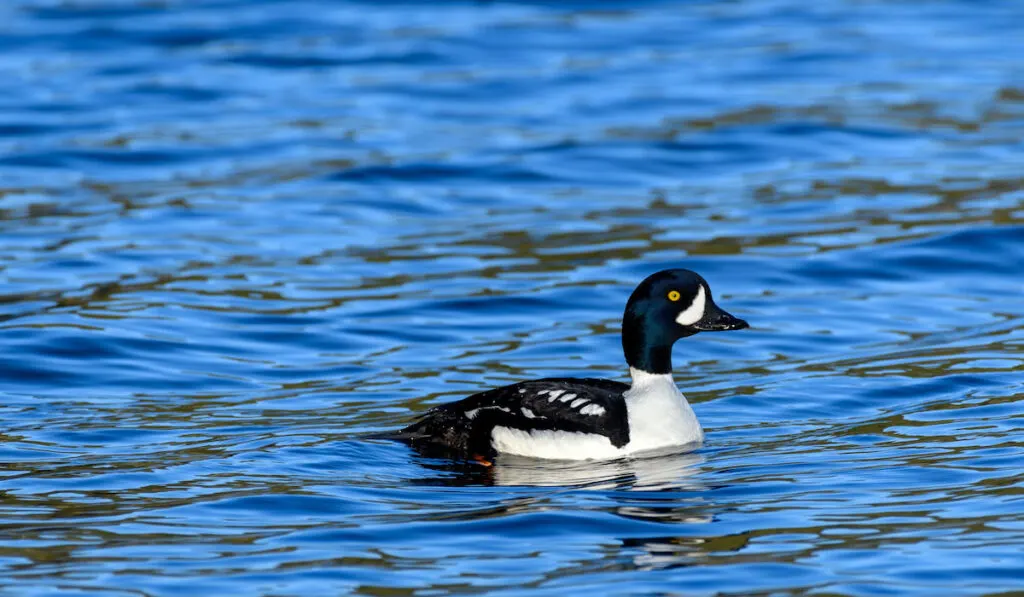
Barrow’s goldeneyes can be found in Northwestern United States, Iceland, and Eastern Canada. They were named after an English statesman named Sir John Barrow. These medium-sized ducks typically inhabit shallow waters, estuaries, rivers, small lakes, bays, and coastal waters.
Barrow’s goldeneyes possess black heads, backs, and tails, white cheeks, breasts, lower flanks, and yellow eyes. Female goldeneyes possess deep brown heads, grayish-brown bodies, and yellow bills. These ducks measure 17 to 19 inches long and weigh 1 to 2 pounds. They also have a wingspan of 28 to 29 inches.
Depending on where they live, Barrow’s goldeneyes may feed on various things including aquatic insects and larvae, crustaceans, mollusks, and plant materials. Female ducks can lay 5 to 14 bluish green eggs that take 28 to 34 days to be incubated.
Lesser Scaup (Aythya affinis)
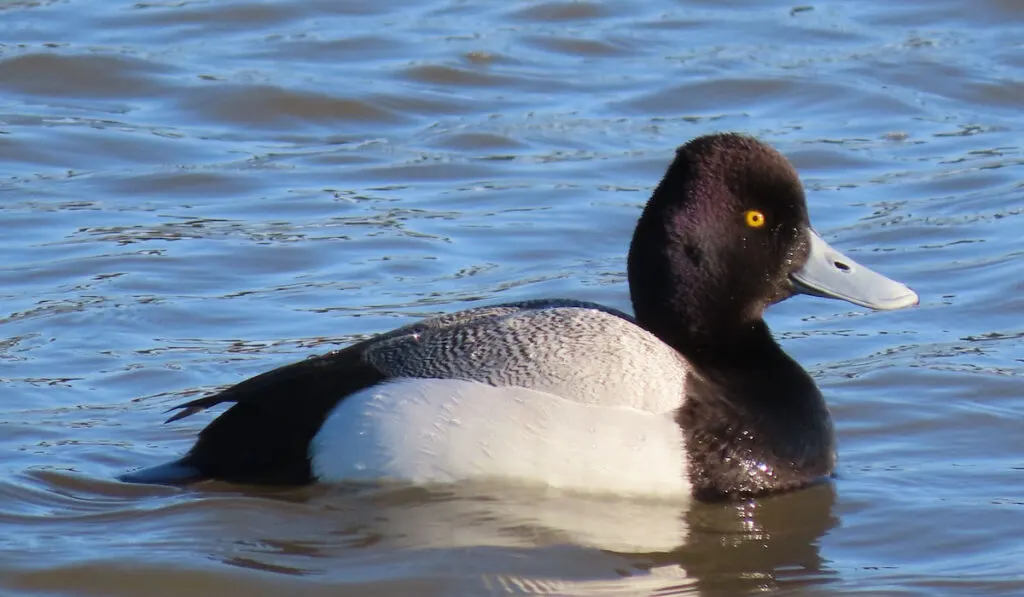
These small diving ducks are distributed in many parts of North and South America including Canada, Central America, Northern Colombia, Bermuda, and the United States.
They are also known as the broadbill ducks or the little bluebill ducks. Their habitats vary from estuaries to lakes to ponds, rivers, and coastal bays.
Lesser scaups measure 15 to 19 inches and weigh 1 to 2.4 pounds. Their wings can extend up to 31 inches wide. These ducks possess iridescent black heads, whitish-gray backs and wings, yellow eyes, and dull gray bills.
Meanwhile, female scaups are slightly different with deep brown heads, mottled-brown bodies, and white patterns on their bills.
Lesser scaups thrive on an omnivorous diet that consists of mollusks, aquatic insects, crustaceans, snails, and plant materials. They usually nest behind thick vegetation close to the water. On average, female scaups can lay 8 to 14 olive buff eggs per clutch. These eggs will be incubated between 21 to 27 days.
Smew (Mergellus albellus)
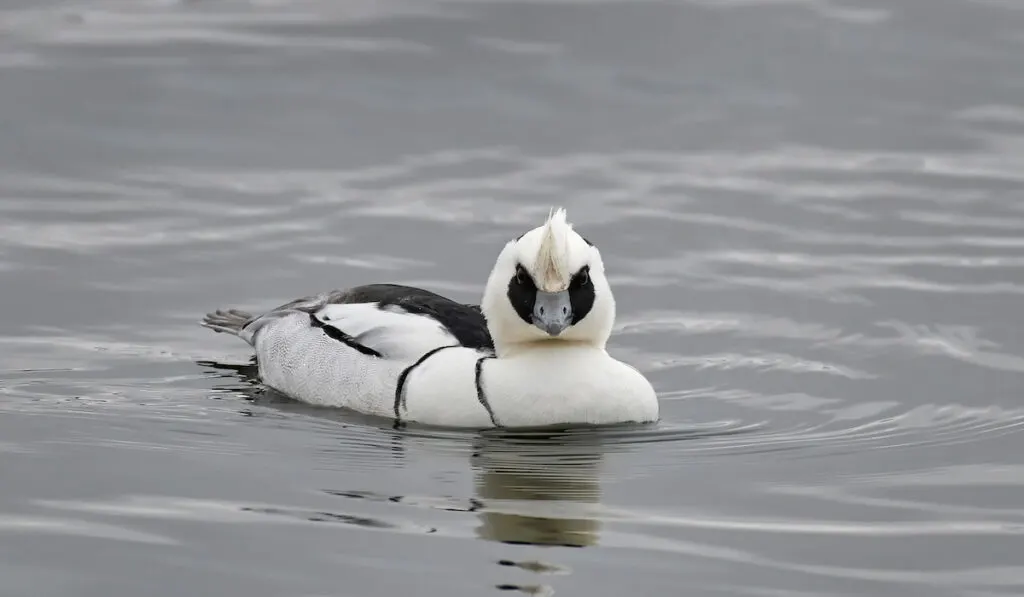
Smews can be found in Northern Europe, Asia, Alaska, and a few places in North America. In the United States, they are distributed near California and along the Pacific coasts.
These ducks are closely related to the goldeneye species. They also prefer to live in different habitats such as lakes, slow-moving rivers, and coastal waters.
Smews possess distinctive black and white bodies with black patterns around their eyes and cheeks and black bills.
Meanwhile, female smews have gray bodies and bills with chestnut heads and white patches around their necks. These small ducks measure 15 to 17 inches long and weigh 16 to 23 ounces. Their wings also can extend 22 to 27 inches wide.
These ducks can be found nesting under small trees or inside tree holes. Female smews typically lay 7 to 11 cream-colored eggs before incubating them for 26 to 28 days. Unlike most wild ducks, smews are much quieter and don’t produce any obvious calls.
Bufflehead (Bucephala albeola)
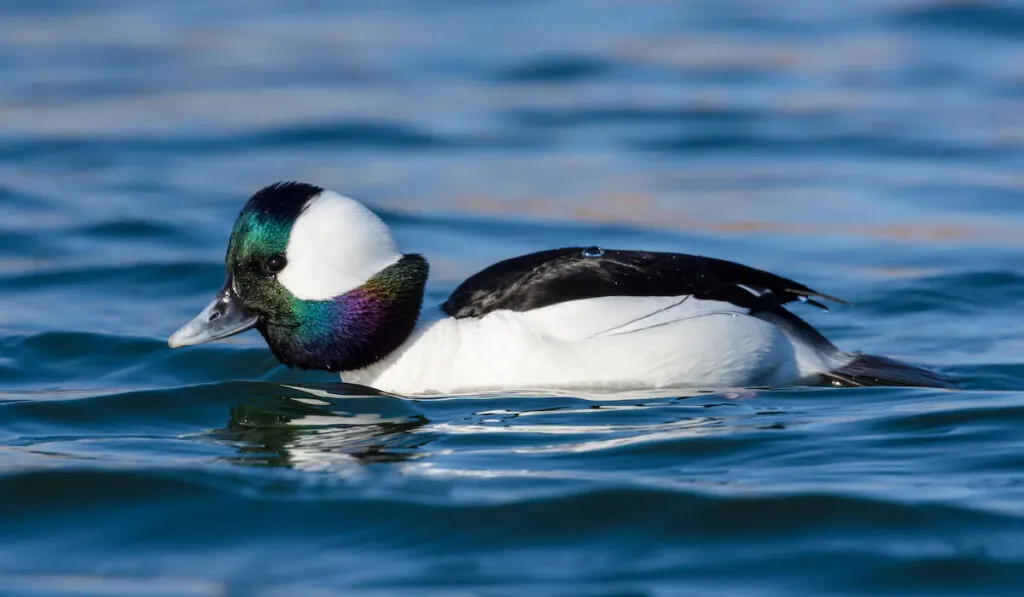
Bufflehead ducks are another species that is related to the goldeneye breed. These ducks are distributed in Western Canada, Alaska, Western Europe, the Southern United States, and along the west and east coasts of North America. They can be found in many types of habitats such as lakes, deep ponds, rivers, and sheltered coastal waters.
These small ducks can be recognized by their iridescent purplish-green heads and white patterns on the back of their crowns, black backs, white breasts and wings, and dull gray bills. Meanwhile, female ducks have grayish bodies, black backs and heads, and white patches under their eyes.
Bufflehead ducks measure 13 to 16 inches long and weigh 10 to 19 ounces. Their wings can extend up to 22 inches wide.
Bufflehead ducks feed on various things including mollusks, aquatic insects, crustaceans, fish eggs, and some aquatic plants. They nest inside tree cavities and close to the water. Female ducks can lay 6 to 11 eggs per clutch before incubating them for 30 days.
Long-tailed Duck (Clangula hyemalis)
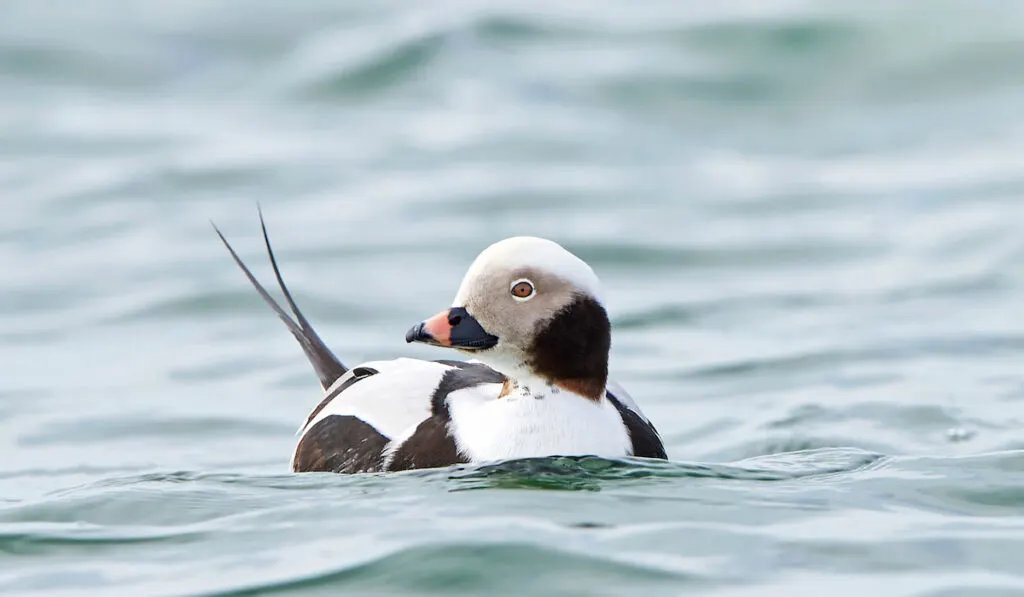
Long-tailed ducks can be found in various parts of northern waters such as Hudson Bay, the Bering Sea, the Great Lakes, and as far as the Arctic. They nest and live in many types of habitats including lakes, coastal waters, tundra, open waters, and icy regions.
These medium-sized ducks can be distinguished by their white plumage and random black patches scattered all over their bodies and heads, dark gray bills, and pointy long black tails.
Female ducks are slightly different with brown plumage and random dark brown patches scattered all over their bodies and heads, dark gray bills, and white faces.
Long-tailed ducks measure 18 to 24 inches long and weigh 2 pounds. Their wings can extend up to 28 inches long. These ducks feed mainly on aquatic creatures such as small fish, mollusks, and crustaceans.
On average, female ducks can lay 5 to 11 olive buff eggs that take 24 to 29 days to be incubated. Their nests are built behind rocks or vegetation and close to the water.
Common Goldeneye (Bucephala clangula)
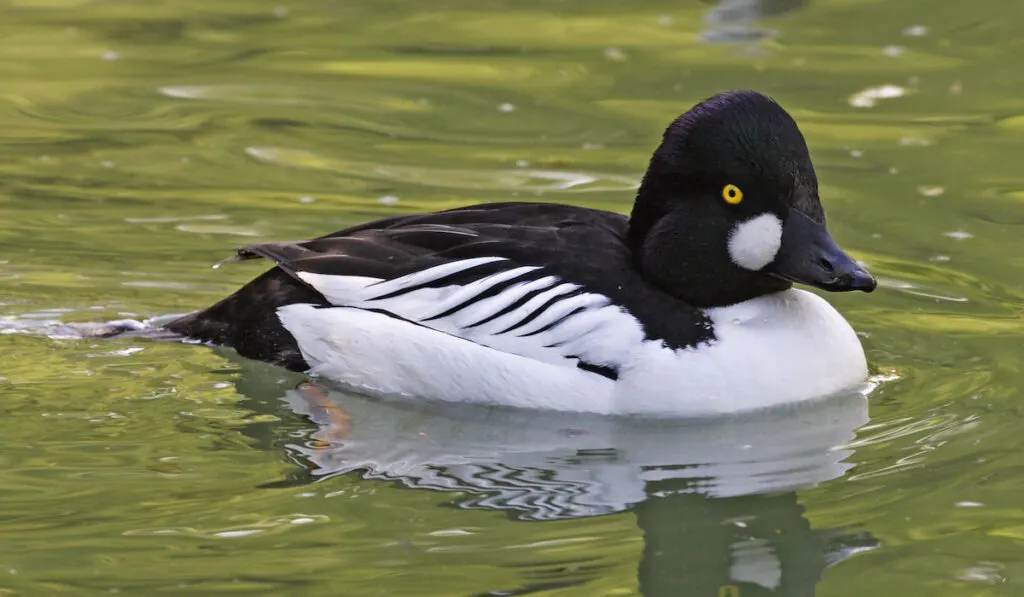
Common goldeneye ducks are distributed in North America, Europe, Asia, Canada, and Northwestern United States. They can be found in several types of habitats such as rivers, ponds, lakes, marshes, estuaries, sheltered bays, and coastal waters.
These medium-sized ducks are characterized by their iridescent black heads, black bills, white patches on their cheeks, yellowish-golden eyes, and black-and-white bodies. Female ducks possess grayish bodies with dark brown heads and black bills.
Common goldeneye ducks measure 17 to 19 inches long and weigh 1.7 to 2.3 pounds. These ducks feed on various things including aquatic insects, mollusks, crustaceans, small fish, and aquatic plants. On average, female ducks can lay around 9 eggs per clutch. They usually nest in tree cavities near water.
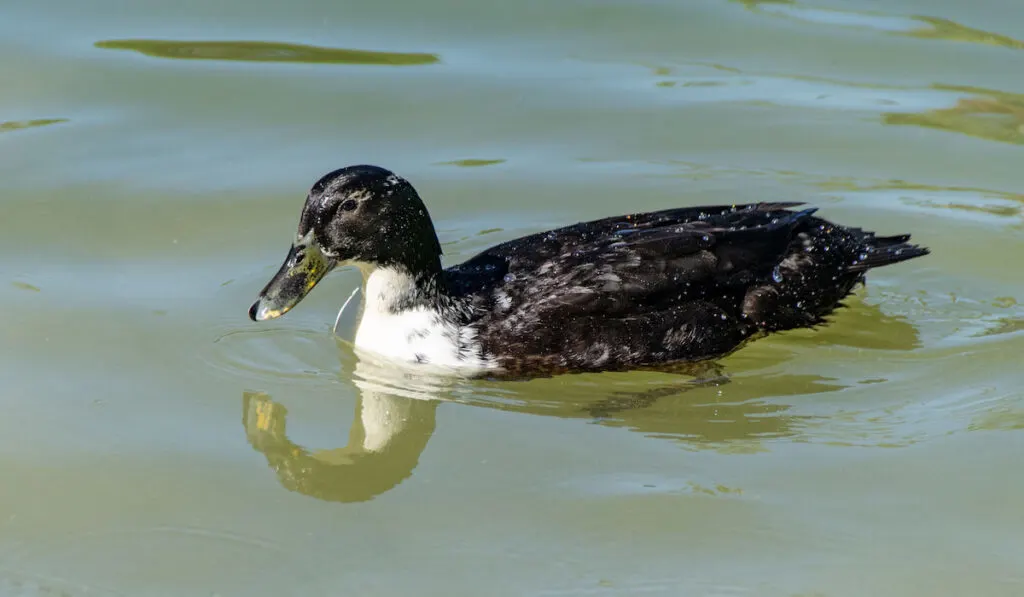
Can Mallard Ducks be Black and White?
Mallard ducks are well-known for their striking green head, yellow bills, and feathers that come in a combination of colors such as gray, pale white, dark and light brown, as well as chestnut.
Meanwhile, female mallards are slightly different with mottled-brown feathers and brownish-orange bills.
But can mallard ducks be black and white? Are there any black and white Mallards in the wild?
Black and white mallard ducks do exist. But they aren’t naturally born with this color. Most black and white mallards are hybrid species. Mutations also occur, which give rise to these rare plumage colors found in this species.
Hybrid mallards are usually developed through a crossbreeding process between wild mallards and other ducks with all black or black and white plumage such as Northern Pintail, American Black Duck, Muscovy, and many more.
Additionally, depending on the colors found on the other duck, hybrid mallards can also produce different feather colors such as light brown, mottled, and whitish-brown.
Final Thoughts
Keep in mind that all these black and white ducks exist because they breed within their own flocks. If you choose to crossbreed them with ducks from different species with different colorful plumages, it is possible that the ducklings may carry both genes from their parents and grow up to have different plumage colors.
Resources
- https://www.allaboutbirds.org/guide/Mallard/
- https://beautyofbirds.com/mallardhybrids/
- https://www.audubon.org/field-guide/bird/hooded-merganser
- https://animaldiversity.org/accounts/Lophodytes_cucullatus/
- https://birdfact.com/birds/tufted-duck
- https://en.wikipedia.org/wiki/Tufted_duck
- https://www.audubon.org/field-guide/bird/common-eider
- https://en.wikipedia.org/wiki/Common_eider
- https://animaldiversity.org/accounts/Aythya_collaris/
- https://www.audubon.org/field-guide/bird/ring-necked-duck
- https://www.audubon.org/field-guide/bird/white-winged-scoter
- https://en.wikipedia.org/wiki/White-winged_scoter
- http://www.moosemanorfarms.com/about-ancona-ducks.html
- https://www.thehappychickencoop.com/ancona-duck-breed-everything-you-need-to-know/
- https://www.audubon.org/field-guide/bird/king-eider
- https://en.wikipedia.org/wiki/King_eider
- https://www.audubon.org/field-guide/bird/barrows-goldeneye
- https://en.wikipedia.org/wiki/Barrow%27s_goldeneye
- https://www.audubon.org/field-guide/bird/lesser-scaup
- https://en.wikipedia.org/wiki/Lesser_scaup
- https://www.audubon.org/field-guide/bird/smew
- https://en.wikipedia.org/wiki/Smew
- https://en.wikipedia.org/wiki/Bufflehead
- https://www.ducks.org/hunting/waterfowl-id/bufflehead
- https://en.wikipedia.org/wiki/Long-tailed_duck
- https://www.audubon.org/field-guide/bird/long-tailed-duck
- https://www.ducks.org/hunting/waterfowl-id/common-goldeneye
- https://ebird.org/species/comgol
